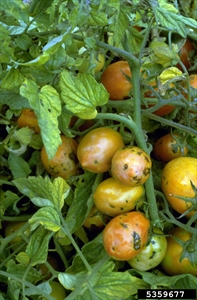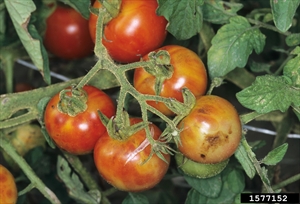Tomato spotted wilt
Pacific Pests, Pathogens and Weeds - Online edition
Pacific Pests, Pathogens & Weeds
Tomato spotted wilt (481)
Tomato spotted wilt; it is caused by Tomato spotted wilt tospovirus. The abbreviation is TSWV.
Asia, Africa, North, South and Central America, the Caribbean, Europe, Oceania. It is recorded from Australia, Cook Islands, New Zealand, and Papua New Guinea.
A wide range of field and greenhouse crops, and ornamentals are hosts. This includes plants in more than 90 families, with Asteraceae, Solanaceae and Fabaceae the most common. The hosts of economic importance are: capsicum, lettuce, pea, potato, tobacco, tomato, and many ornamentals. Peanut is a host of TSWV in the USA. Many weeds are hosts.
A serious virus disease with symptoms varying among the many hosts, and even within a single species depending on age, nutrition and environment. The disease is common in temperate, sub-tropical and tropical regions. Symptoms on important hosts are:
- Tomato: plants stunted (if infected when young), leaves droop, become bronzed with spots and dark streaks (Photos 1&2); streaks also develop on petioles and stems. Green fruit with distortions and irregular dark spots (Photos 3&4), and ripe fruits with yellow or black spots, ringspots, and mosaics patterns (Photos 5&6).
- Capsicum: symptoms are similar to tomato, with stunting and yellowing, dark streaks on the stems, and yellow spots on the fruits (Photo 7).
- Potato: leaves have dead spots or patches, sometimes with concentric rings (like a dart-board). Plants from infected 'seed' (tubers) are stunted and also show spots and blackening internally.
- Lettuce: a one-sided yellowing with brown patches, and distorted growth.
- Ornamentals: stunting, black leaf spots, stem streaks and wilts are common.
Spread is by thrips, with western flower thrips (Frankiniella schultzei) and onion thrips (Thrips tobacci) being the most important. Of the two, western flower thrips is more efficient at spreading TSWV. Thrips pick up TSWV as nymphs (not adults). Once thrips are infected with TSWV they remain infected for life. In potato, spread is by planting infected 'seed' tubers; spread in true (botanical) seed is not considered important in any of the many hosts. Survival of TSWV is in weeds, volunteer plants, and within thrips. For more information on these two thrips species, see Fact Sheet nos. 117 & 183.
Heavy losses were reported due to TSWV in the USA and Canada on tomato and lettuce in the 1980s; later, increases occurred in greenhouse-grown vegetables, field crops and ornamentals worldwide as trade increased and the western flower thrips was spread more widely by horticultural industries. TSWV is considered one of the world's most economically important plant viruses.
Look for dark spots on leaves, streaks on petioles and stems, and importantly yellow-red ringspots, mosaics and irregular dark spots on fruits. As symptoms vary between hosts, age of infection and environments (especially temperature), it is important to seek expert testing, using sensitive serological or molecular methods. Petunia hybrids and tobacco species (particularly Nicotiana benthamiana) are used as indicator plants.
BIOSECURITY
The management of Tomato spotted wilt virus involves the control of thrips. Exclusion is an important part of the strategy. Pacific island countries that are not yet infested by TSWV should consider all likely pathways for entry, and apply quarantine measures accordingly. Particular attention should be given to the risks associated with the trade in vegetables from Pacific-rim countries. A contingency plan for an incursion of a range of viruses transmitted by thrips, including TSWV, has been prepared by Plant Health Australia: (https://www.planthealthaustralia.com.au/wp-content/uploads/2013/03/Thrips-transmitted-viruses-CP-2011.pdf).
NATURAL ENEMIES
Natural enemies include Orius, Geocoris and Nabis species and also the larvae of lacewings, but all these are general predators. Also, predatory mites (Transieus and Amblyseius species) and predatory thrips (Haplothrips) are common, but do not adequately control thrips populations, except under greenhouse conditions, where they are used as part of IPM programs. Commercial strains of Beauveria bassiana are available against western flower thrips, and registered in Australia.
CULTURAL CONTROL
Western flower thrips is more difficult to control than other thrips species because it develops resistance to pesticides rapidly. Cultural control options aim to prevent infection and minimise spread. Monitoring is an important part of cultural control strategies.
Before planting:
- Check seedlings to ensure that they are free from symptom. It is best for farmers to raise their own seedlings, plant only certified seed, or source seedlings only from nurseries that are screened with thrips-grade mesh, and monitored for western flower thrips and TSWV.
- Remove weeds from within and around crops. Note, thrips and TSWV have very wide host ranges, including many weeds. Grasses, however, are poor hosts and could be used around greenhouses and nurseries to reduce the need for management of other weeds that are hosts. A 10 m strip around greenhouses and nurseries or around crops is sufficient. Bare ground is also effective. Thrips are not strong flyers.
- Do not plant new crops next to those infested by thrips; preferably, do not plant overlapping or consecutive crops on the same land without a break: use a rotation; and do not plant new crops downwind from those infested with thrips. These measures are especially important if the 'old' crop is infected with TSWV.
During growth:
- Monitor routinely for thrips. Use yellow or blue sticky traps placed about 10 cm above the crop, and inspect weekly.
- Do not apply excessive amounts of nitrogen fertilizer which can lead to high thrips populations.
- Control weeds.
- Rogue any plants showing symptoms of virus.
After harvest:
- Collect and destroy crop debris by burying or burning.
RESISTANT VARIETIES
There are resistant varieties of cucumber and tomato to TSWV. Carry over of TSWV in potato seed tubers differs between varieties; source those with low carry-over to avoid spread to potato and other crops.
CHEMICAL CONTROL
Insecticides are often not effective in the control of TSWV; this is because (i) thrips may be hidden within flowers and leaves and are difficult to target by sprays; (ii) eggs are inserted into the leaves making it difficult for sprays to reach them; and (iii), thrips rapidly become resistant to insecticides, so much so that there are large differences in the susceptibility of thrips populations to commonly used products.
Use insecticides as follows, but note that frequent use of broad-spectrum synthetic insecticides may lead to development of insecticide resistance in thrips populations, and should be avoided:
- Use horticultural oil (made from petroleum), white oil (made from vegetable oils), or soap solutions (see Fact Sheet no. 56). The spray will not kill all the thrips, but it will suppress the population enough to allow predator and parasite numbers to build up and start to control them.
- Several soap or oil sprays will be needed to bring the thrips under control. It is essential that the underside of leaves and terminal buds are sprayed thoroughly since these are the areas where the thrips congregate. It is best to spray between 4 and 6 pm to minimise the chance of leaves and flowers becoming sunburnt. Test the soap and oils on a few leaves or flowers.
- White oil:
- 3 tablespoons (1/3 cup) cooking oil in 4 litres water.
- ½ teaspoon detergent soap.
- Shake well and use.
- Soap:
-
Use soap (pure soap, not detergent).
- 5 tablespoons of soap in 4 litres water, OR
- 2 tablespoons of dish washing liquid in 4 litres water.
-
- White oil:
- Commercial horticultural oil can also be used. White oil, soap and horticultural oil sprays work by blocking the breathing holes of insects causing suffocation and death. Spray the undersides of leaves; the oils must contact the insects.
- Use neem to discourage adults from feeding and laying their eggs on the plants (see Fact Sheet no. 56).
- Use products registered in Australia, including abamectin, Beauveria bassiana, spinosad, spinetoram, spirotetramat.
- Do not use broad-spectrum insecticides such as dimethoate (under review in Australia, and not allowed for use in home gardens), malathion or synthetic pyrethroids. They have a greater effect on the natural enemies of western flower thrips than on thrips itself.
____________________
When using a pesticide, always wear protective clothing and follow the instructions on the product label, such as dosage, timing of application, and pre-harvest interval. Recommendations will vary with the crop and system of cultivation. Expert advice on the most appropriate pesticides to use should always be sought from local agricultural authorities.
AUTHOR Grahame Jackson
Information from CABI (2020) Tomato spotted wilt virus (tomato spotted wilt). Crop Protection Compendium. (https://www.cabi.org/cpc/datasheet/54086); and Tomato spotted wilt virus in potatoes (2020) Agriculture Victoria. (https://agriculture.vic.gov.au/biosecurity/plant-diseases/vegetable-diseases/tomato-spotted-wilt-virus-in-potatoes); and Sherwood JL, et al. (2009) Tomato spotted wilt. The Plant Health Instructor. APS. DOI: 10.1094/PHI-I-2003-0613-02; and from Schwartz HF, Gent DH (2016) Tomato spotted wilt. High Plains Integrated Pest Management. BugwoodWiki. (https://wiki.bugwood.org/HPIPM:Tomato_Spotted_Wilt). Photo 1 Don Ferrin, Louisiana State University Agricultural Center, Bugwood.org. Photos 2,3,6,7 Gerald Holmes, Strawberry Center, Cal Poly San Luis Obispo, Bugwood.org. Photos 4&5 William M. Brown Jr., Bugwood.org.
Produced with support from the Australian Centre for International Agricultural Research under project HORT/2016/185: Responding to emerging pest and disease threats to horticulture in the Pacific islands, implemented by the University of Queensland and the Secretariat of the Pacific Community.










